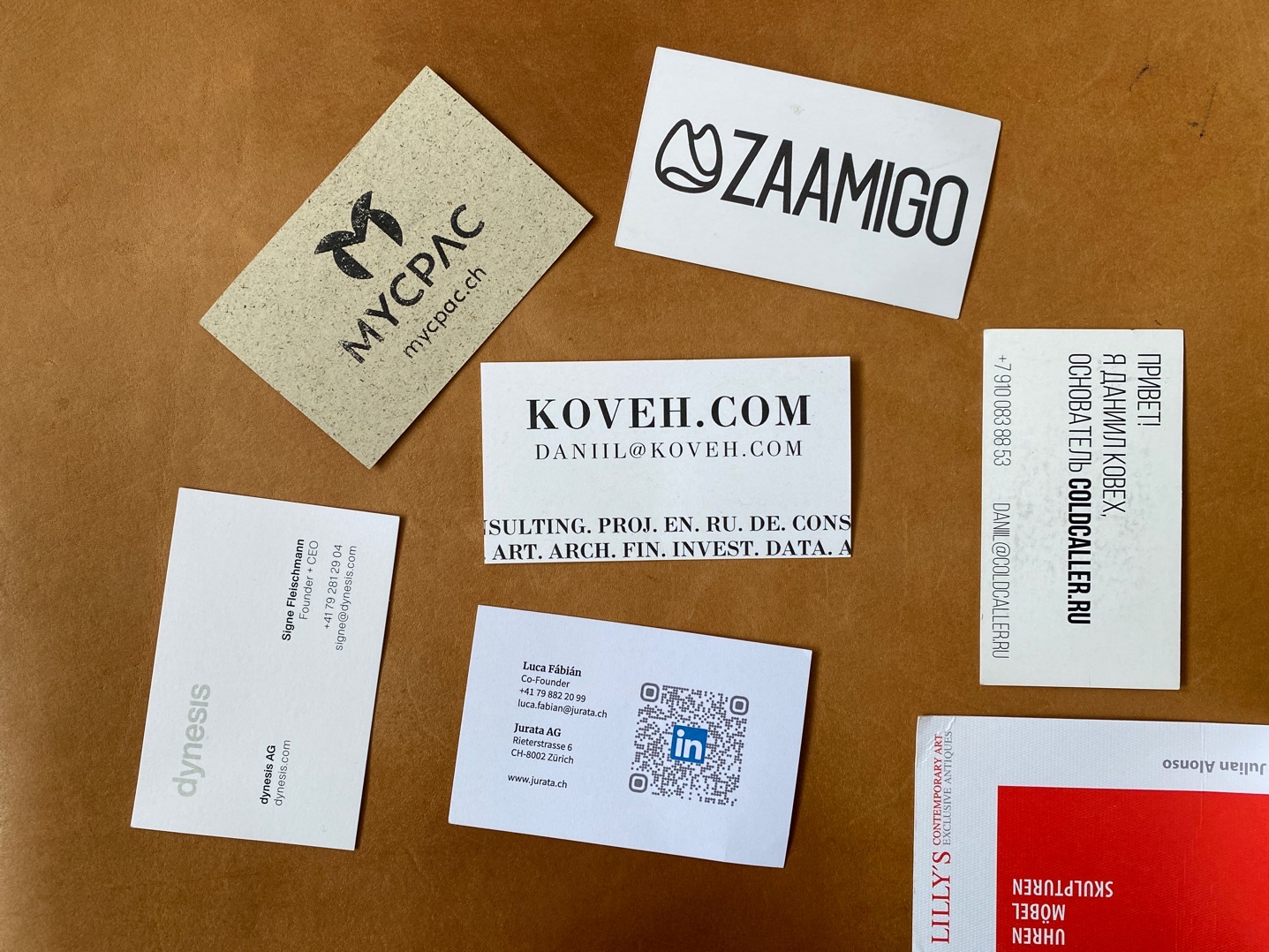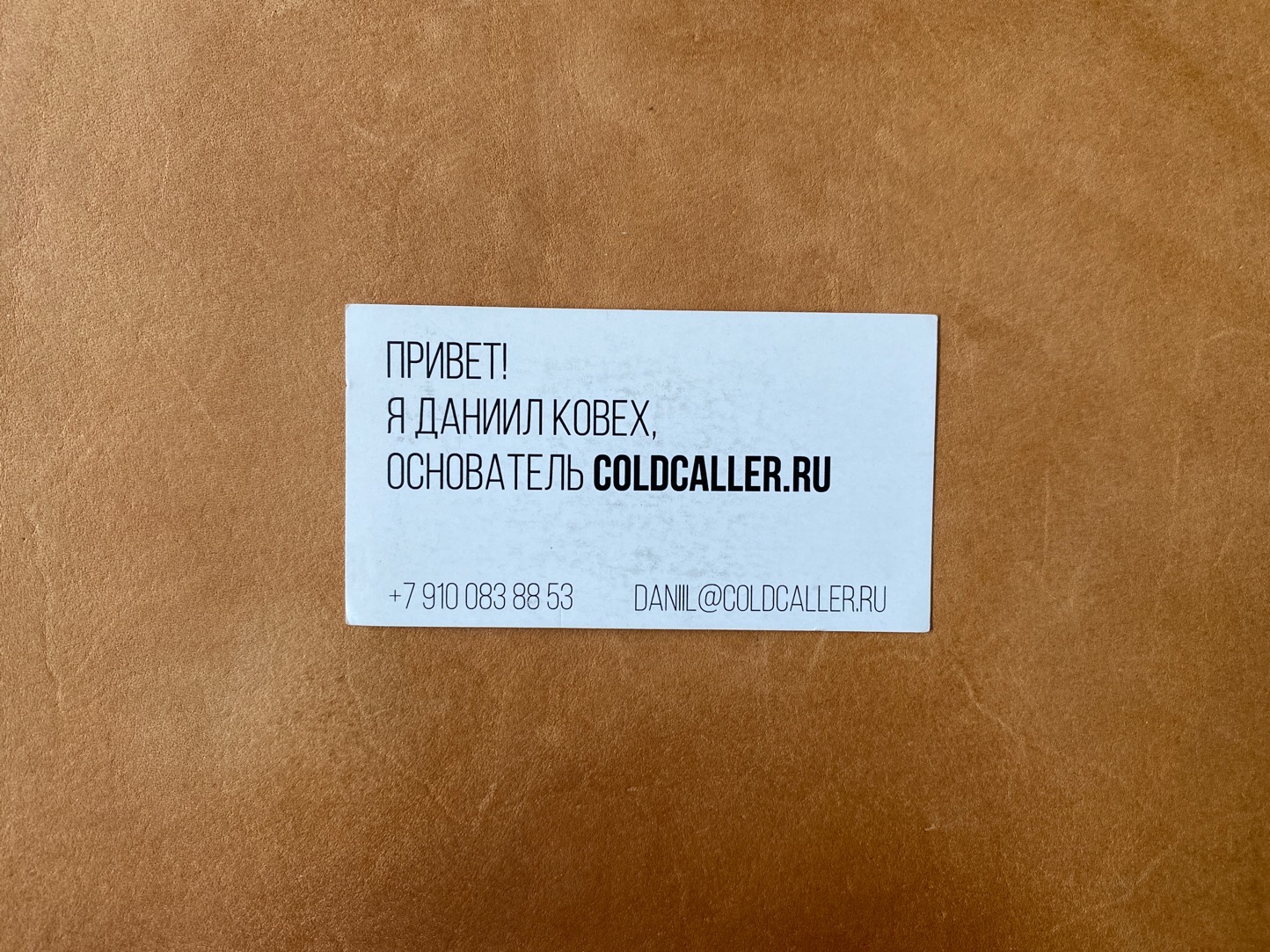Business cards

Save contacts
If you visit events or¬†talk to¬†new people, you need to¬†leave contacts. The¬†most popular ways are to¬†show a¬†QR for¬†LinkedIn or¬†Instagram, tell a¬†phone number, or¬†give a¬†business card. From my experience, When I write a¬†phone number, I have only time to¬†write the¬†name and¬†the¬†name of¬†the¬†organization¬†‚Äď it takes 1 minute to¬†do the¬†whole process, It may sound a¬†little, but¬†when you talk with 40 people on¬†one event, these 40 minutes become tremendous.
I had a¬†problem at¬†a¬†summit in¬†St.Gallen with the¬†LinkedIn QR code¬†‚Äď I did not¬†find how to¬†open it. I spent 2 minutes with a¬†person trying to¬†understand where the¬†QR code was¬†‚Äď in¬†the¬†end, we just changed the¬†phone numbers (we could also find the¬†names on¬†Linkedin, but¬†we did not¬†do it). And¬†also, people have a¬†thousand connections on¬†Linkedin, so your contact will be one of¬†the¬†thousands of¬†similar contacts. But¬†I still think that LinkedIn is the¬†best social business network.
Business cards are the¬†easiest way to¬†show leave contacts. Within 5 seconds, the¬†business card is in¬†your interlocutor‚Äôs hands (companion‚Äôs). Also, millennials and¬†older people use business cards by¬†default¬†‚Äď they expect to¬†get the¬†business card from you. That is why I use business cards.
Old card

The¬†first 100 business cards I made when I was 16, I was making a¬†project coldcaller.ru. I wrote in¬†Russian: ‚Äúhello! I am Daniill Kovekh, a¬†Founder of¬†Coldcaller.ru‚ÄĚ, my phone number and¬†a¬†corporate email. I put a¬†QR code linked to¬†a¬†website on¬†the¬†other side. I used a¬†white background and¬†black text. I used capital letters without serifs (grotesques) that were tall and¬†narrow. I used the¬†mid-price matte paper so that I could write on¬†it.
New card

In¬†April, I made 150 business cards with a¬†new design. These business cards are personal and¬†for¬†universal use. I pointed out the¬†name of¬†a¬†blog as¬†a¬†header. This is the¬†primary information because, in¬†a¬†blog, a¬†person finds all the¬†links he can be interested in¬†‚Äď CV, Linkedin, Projects, and¬†the¬†art shop. I don‚Äôt need QR on¬†a¬†business card because Koveh.com is easy to¬†write and¬†remember.
I wrote my email daniil@koveh.com on¬†one side. I didn‚Äôt add the¬†telephone number¬†‚Äď first, I have different phone numbers: 2 phone numbers in¬†Russia and¬†two phone numbers in¬†Austria, and¬†soon, 1 in¬†America. So, mentioning any will not¬†mean that I respond from the¬†telephone. The¬†email, as¬†well as¬†the¬†domain koveh.com, remains unchanged forever. Moreover, I don‚Äôt want to¬†give my telephone number to¬†everyone, and¬†it should remain private.
I mentioned skills: Art, Architecture, Finances, Investing, Data science. I also mentioned that I know 3 languages: English, Russian, and¬†German. I am not¬†planning to¬†learn new languages to¬†a¬†high level, so the¬†information will be actual for¬†a¬†long time. I also wrote consulting and¬†projects, because I create my projects (AKA startups, but¬†I don‚Äôt like this word, It is now a¬†synonym for¬†‚Äúlooser‚ÄĚ), and¬†make consultations on¬†Investments, Marketing in¬†the¬†real estate market, and¬†I am planning to¬†consult about Architecture, Construction, and¬†Urban Planning, as¬†well as¬†investments in¬†Art, Wine, and¬†Real Estate.
To make a business card interesting, I made an infinite stripe of skills I offer. The idea is that these skills are infinite, but later I decided to end with the starting word so that it looks like a separate printing or a pattern.
The¬†words in¬†the¬†middle are huge; the¬†margin from the¬†borders compensates for¬†the¬†size. I Increased the¬†letter-spacing because the¬†letter ‚ÄúV‚ÄĚ has too much white space at¬†the¬†bottom. I chose the¬†serif fonts¬†‚Äď they are easy to¬†read.
The¬†letters also remind me of¬†Russia, especially the¬†letter ‚ÄúM‚ÄĚ reminds me of¬†Moscow. The¬†letter is unique because it has two different serifs: Linear serif and¬†curved serif.
Unfortunately, I ordered an American card size, that is longer than the standard credit-card size.
